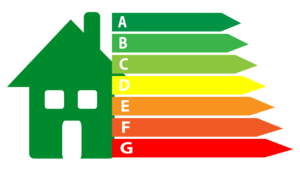
As part of the Government’s strategy for the UK to reach net zero by 2050, Boris Johnson has outlined that the UK has already reduced emissions by 44 per cent at the same time as growing the economy by over 75 per cent but more needs to be done and can be done. Alongside other strategies, a focus on making the housing stock of the UK more energy efficient is a priority for the Government. In this article, we look at how this could affect you as a landlord.

How Has This Come About?
The Government’s Heating and Buildings Strategy sets out how the UK will decarbonise homes along with commercial, industrial and public sector buildings, as part of the Government’s commitment to the UK becoming net zero by 2050. Minimum Energy Efficiency Standards (MEES) were introduced in March 2015 as part of the Energy Efficiency (Private Rented Property) (England and Wales) Regulations 2015, meaning that landlords cannot renew or grant a new tenancy of 6 months or longer if a property has an EPC rating below an ‘E’ standard. Additionally, landlords face the prospect of paying greater mortgage premiums if they buy or re-mortgage any property that does not meet the minimum EPC standards.
What Are The Minimum EPC Standards?
Introduced by the Government in 2008, the Energy Performance Certificate (EPC) gives a rating on a scale of A (excellent) to G (poor) as to how energy efficient a property is. It is a requirement for landlords to obtain a new energy performance certificate for their rental properties every ten years. The Energy Performance Certificate gives information to both landlords and tenants alike, breaking down the energy efficiency of the property, giving the landlord pointers as to how to raise the EPC rating and giving tenants an estimation of the likely energy bills.
The Minimum Energy Efficiency Standards (also known as MEES) are the minimum energy efficiency levels, set and enforced by the Government and apply to all domestic private rented properties that have a legal responsibility to have an Energy Performance Certificate (EPC).
This includes those that have been let or marketed for sale in the past 10 years and are let on specific types of tenancy agreement, such an assured, regulated, or domestic agricultural tenancy.
The Regulations currently require properties to hold an EPC rating of ‘E’ or above but a government consultation was carried out at the beginning of 2021 to look at having all rented properties being required to have a minimum EPC rating of C by 2030 so the regulatory landscape is moving.
Further information for landlords on MEES can be found here.
How Will Mortgage Lenders Impose the Higher Rates?
The expectation from the Government is that landlords and homeowners will make any changes needed to bring properties into line on a voluntary basis, with lower interest rates offered by lenders on green mortgages (a mortgage designed to help a borrower make their property more energy efficient) as the incentive. However, if the lure of the lower rates of green mortgages doesn’t do the trick, the Government is proposing to make it mandatory for mortgage lenders to have all properties reach EPC Band C by 2030.
With an estimated 17 million homes in the UK falling within EPC band D or below and the estimated cost of upgrading these properties stands at an eye-watering £65 billion, it will remain to be seen how successful the plan becomes but it is clear that the energy performance of private domestic rental properties is very much an area of focus for the government so it will be beneficial for landlords to understand the current regulations and also start preparing for possible new regulations in the future.



